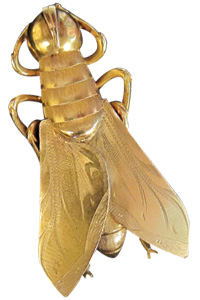|
Cover
Passion and Soul
Beverly and Stephen Forward bring a special touch to their period and antique collections at their Beverley R boutique.
By Joyce Kauf
 |
| Bug brooch, circa 1880, English. |
Antique jewelry has a soul,” says Beverly Forward, explaining the passion for antique and period jewelry that she shares with Stephen Forward, her British-born husband and business partner in Beverley R Ltd., their boutique located on Chicago’s Magnificent Mile. The Forwards have focused their refined collective eye on the selection of unique jewelry that spans the Georgian, Victorian and Edwardian eras, Art Deco and the 1940s and 1950s.
Guided by the belief that “jewelry is something you fall in love with,” Beverly believes jewelry should bring a smile to a woman’s face. It has been a lifelong obsession for Beverly, who turned her “enchantment” with the clothes and jewelry in the old movies that she watched as a child into a 30-year career in the U.S. and England.
While Stephen admits to always having an interest in jewelry, he owned a transportation company in London when the couple met. However, after their marriage, he gradually became more involved in Beverly’s jewelry endeavors. After receiving certification from Gem-A, the Gemmological Association of Great Britain, Stephen sold his company and joined Beverly at Grays Antiques, located near London’s exclusive Bond Street, selling jewelry first to the trade and then expanding to consumer retail. After several years, Beverly, a Chicago native, decided it was time to move home to be closer to her family.
“What we love most about the pieces we carry is that most of them are one of a kind,” Beverly notes. The couple’s deep appreciation for period jewelry stems from the fact that all the work is done by hand — especially pieces from the Georgian period. “Look at the craftsmanship and detailing, even on the back,” Stephen marvels. “We look at quality before anything else,” explains Beverly, noting they will reject pieces not worked on by fine jewelers. “When you buy from us, it is not just a piece of jewelry but a mini work of art,” says Stephen in describing the hand-selected pieces. In choosing the jewelry, the couple meshes their complementary skills. “Beverly focuses on style, design, period and setting, while I look more at the gemstones,” explains Stephen.
“A signature on a piece does not necessarily denote quality,” Beverly explains. She is also emphatic about drawing a distinction between “estate” and antique jewelry. “Estate is something that is pre-owned. It could have been made a week ago. In Europe, antiques have to be at least 100 years old,” Beverly goes on to say. “Antique jewelry also stands the test of time — and makes a good investment as well,” Stephen asserts.
Enhanced with antique moldings dating from the late nineteenth century, the store, located on East Walton Street, close to the Drake Hotel, is a destination spot for visitors from neighboring states as well as foreign tourists. Some customers know exactly what they want. “However, it is often a case of educating people,” says Stephen, who enjoys the opportunity to convey the couple’s love and respect for the jewelry. “Being a small jewelry boutique is a wonderful thing. We can take the time with customers. Even if we do not know the provenance of the specific piece, we can explain its historical context.”
Beverly and Stephen have seen a shift in customer attitudes toward period pieces. The recession made customers more selective, but more importantly, their rationale for buying changed, which has had an impact on the pieces the couple select for the boutique. Instead of buying for a collection to be kept under glass, women want pieces that can go from day to night. “They want to dress up and dress down,” says Stephen, pointing out that versatility is a key selling point. He illustrates that concept with a diamond and sapphire bangle that has a center cluster of a sapphire surrounded by diamonds that unscrews and fits into a separate ring mount. Stephen adds that the ability to convert a tiara into a necklace is very common, pointing out that Beverly’s niece borrowed a ruby and diamond tiara for her wedding ceremony, took it off the frame and wore it as a necklace at her reception.
“Our designs are timeless,” says Beverly. “They are endlessly wearable and blend so well with modern tastes,” she continues, pointing to the pair of 18-karat swirling gold drop earrings she is wearing that was salvaged in 1995 from the General Abbatucci, shipwrecked in 1869.
The greatest challenge the couple faces is replenishing pieces that meet their criteria for quality of design and gemstones. “It is harder than selling,” says Beverly, because “once we sell a piece, we cannot get another one again.” They often buy pieces through private collections, since even auction houses offer fewer pieces than they once did.
While the Forwards are collectors themselves, Stephen admits, “With some pieces, you are just the caretaker. You’ve had the pleasure of finding them and taking care of them. But there is also the pleasure of giving them to someone who appreciates them as well,” he concludes. Article from the Rapaport Magazine - May 2013. To subscribe click here.
|
|